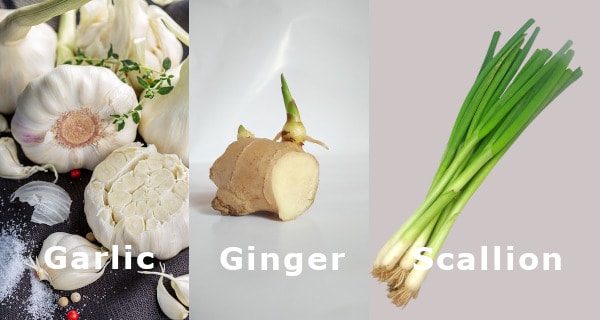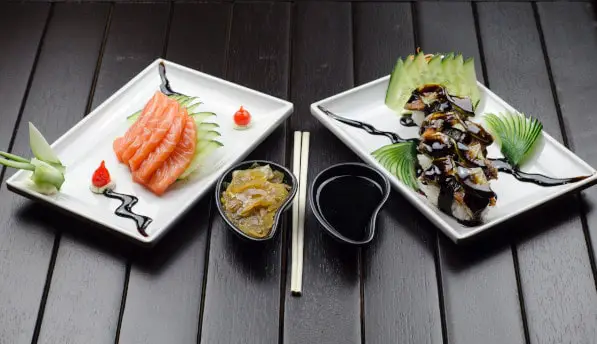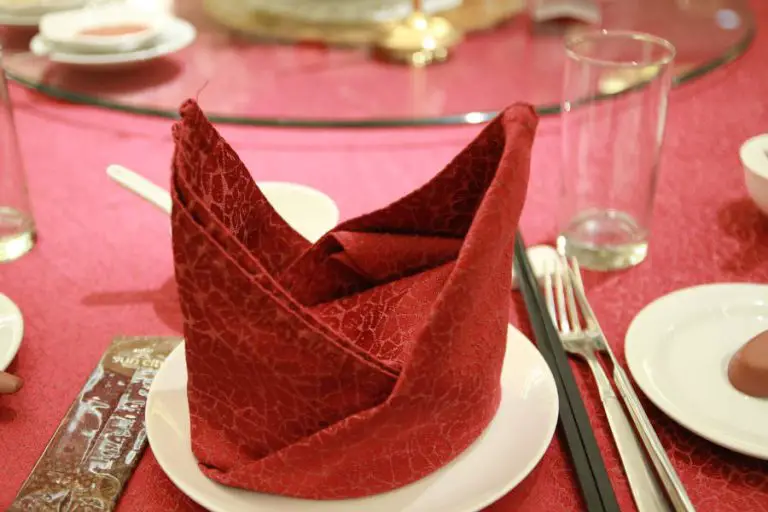Chinese cuisine is rich with its ingredients, condiments, and sauces. So, for those who want to learn Chinese cooking, the proposition can be overwhelming due to the amount of various exotic dishes, some we have never heard before.
However, the truth is you don’t really need too many ingredients to start cooking various famous Chinese dishes, and below we will discuss some of the most important ingredients, sauces, and spices in Chinese cuisine.
Once you have these core ingredients, you can be confident in making various Chinese recipes whether they are stir-fried, boiled, or steamed, whatever your skill level is.
The Holy Trinity of Chinese Cuisine
Let’s begin with the three most important ingredients in Chinese cooking: garlic, ginger, and scallion (green onion):
Garlic
Garlic is obviously an important ingredient in many places all over the world, but it is much more prominent in Chinese and Asian cuisines compared to Western dishes. Garlic is the foundation of many different Chinese dishes, especially in stir-fried Chinese dishes.
When stir-frying with a wok, it’s very important to note that garlic burns easily, so we’d have to work fast.

Ginger
Especially used in various Chinese dishes with seafood ingredients. As in Western cooking, caramelized ginger is an important part of Chinese cuisine, adding that sweet and savory ginger flavor throughout the entire dish. Ginger is used in many different Chinese cuisines from stir-fried dishes to steamed dishes.
Scallion
Scallions are used in many different Chinese cuisines. The Chinese scallion is generally big and long and can reach almost a whole inch in diameter, while the flavor is quite similar to western green onions, Chinese scallion has a coarser texture and thicker spiciness.
Chinese cuisine uses scallions in various cooking techniques from stir-frying—the staple in Chinese cooking—, braising, boiling, grilling, or for marinating meats. While we can use western green onions as a substitute for scallions, keep in mind that green onions are sweeter in taste, so you might want to adjust the other ingredients accordingly.
Related reading: “Hot Pot: Unveiling the Interactive Charm of Chinese Fire Pot” – Opens in new tab
Sauces and Condiments in Chinese Cuisine
Soy sauce
Sheng Chou (生抽), soy sauce or light soy sauce to differentiate it with the western soy sauce. Chinese light soy sauce has a lighter color than regular soy sauce and is much saltier. It is one of the essential sauces in Chinese cuisine, adding the signature savory flavor of Chinese dishes without adding too much brown color. It is used in a wide variety of Chinese dishes.
It is important to note that Chinese light soy sauce is different than Japanese light soy sauce, which contains mirin, uses less sodium, and has a different taste. Japanese light soy sauce is not suitable for most Chinese dishes.

Dark Soy Sauce
Lao Chou (老抽 ), or dark soy sauce tastes slightly sweet and is thicker (stickier) in texture. As the name suggests, it is also darker in color. It is usually used to add the beautiful dark brown color to the dish, so it is mainly used in food coloring rather than enriching the flavor of the dish. Dary soy sauce usually used together with light soy sauce in braising, to create what we call the red braised dish (i.e. red braised pork and beef).
Hoisin Sauce
Also known as Chinese barbeque sauce, is mainly sweet sauce with hints of savory and spicy, making it a very rich-flavored sauce. Hoisin is also famous for its thick consistency and is commonly used for marinating meats, grilled dishes, and stir-fried dishes. The famous Peking duck, for example, is served with hoisin sauce.
Oyster Sauce
Another staple in Chinese cuisine, and as the name suggests, it is made from oysters. Often used in Chinese stir-fry dishes, it has a sweet and savory flavor with a rather sticky texture. It is very savory and rich, and you can easily find oyster sauce in any local Asian market (and even mainstream grocery store).
Here are some suggestions on Chinese cooking ingredients. – Aff.link
Cornstarch
Cornstarch, as the name suggests, is a type of starch and is mainly used in Chinese cuisine as a thickener. However, we can also use cornstarch in various ways. We can, for example, coat chicken or beef in corn-starch before stir-frying it, which will help in tenderizing the meat so it melts in your mouth.
Another common application is to glaze the meat in cornstarch before deep-frying it, creating a super crispy texture. We can also combine cornstarch in stir-fry sauces and in various soups.
Sesame Oil
Sesame oil is one of the most unique condiments in Chinese and Asian cooking, characterized with its rich fragrance and taste. Sesame oil is used in many stir-fried Chinese dishes to create that familiar wok hei flavor.
We can also use the sesame seed to produce sesame oil in some dishes, and sesame oil can come from toasted seeds (so the oil is darker in color) or non-toasted (so the oil is clearer). Sesame oil from toasted seeds has a richer fragrance and taste.
It is also important to note that sesame oil can be overpowering. So use them sparingly and pay attention to the balance with other spices and condiments.
Doubanjiang
Doubanjiang (豆瓣酱) is a spicy paste made of fermented beans, which is a key ingredient in Sichuan cuisine (Sichuan is a region in China with its unique culinary style famous for its spicy dishes).
Doubanjiang is a thick, dark brown paste that tasted spicy, salty and savory, and is essential if you want to cook the famous Mapo Tofu, among other dishes. It adds a rich, spicy taste to any dish, so if you like spicy food, you can use this ingredient to any stir-fried dish to add richness and spiciness in flavor.
Chinkiang Vinegar
Zhen Jiang Xiang Cu (镇江香醋), Chinkiang vinegar or also called old vinegar has a unique dark brown color much like dark soy sauce. This is why it’s also called black vinegar (黑醋, Hei Cu). It has a rich, tart flavor with a pungent aroma, and offers a fermented, woody taste, unlike the lighter rice vinegar.
If balsamic vinegar is important in Western and especially Italian cuisine, Chinkiang vinegar is just as important in Chinese cooking. The famous General Tso’s Chicken, for example, has the Chinkiang vinegar as its essential condiment.
Shaoxing Wine
Shaoxing is the name of a region in China, and the Shaoxing wine is a rice wine coming from the region. Shaoxing wine can be consumed as drinking wine, but can also be used as a cooking wine. Most bottled Shaoxing wines, especially those that are sold outside China are specifically made for cooking purposes.
Keep in mind that there are salted (brined) version of Shaoxing wine, so if you have a salt-restricted diet, you might want to reduce the amount of salt you add to your dish. If you can’t find Shaoxing wine, you can substitute it with dry sherry.
Do you want to learn more about Chinese cuisine? Check out these cooking books – Aff.link
Spices in Chinese Cuisine
Spices are the essence in Chinese cuisine, and unlike Western cooking, many Chinese dishes use seasonings other than salt and pepper, creating distinct and rich flavors.

Here are some important spices in Chinese cuisine:
Five Spice Powder
The traditional five spices are cinnamon, star anise, cloves, fennel, and Sichuan peppercorns, but the composition might vary depending on the brand (or the region you buy it in). It is used to enrich the flavor of deep-fried dishes (like the Taiwanese popcorn chicken) and even to flavor soups and boiled dishes.
Sichuan Peppercorn
The Chinese version of black peppercorns, the Sichuan peppercorns are actually berries from the ash tree and were the original sources of heat and spiciness in Chinese (especially Sichuan cuisine).
The Sichuan Peppercorn creates a numbing sensation known as ma in Chinese cuisine, which when combined with the spiciness (la) of chili, creates the famous ma-la of Sichuan cuisine. Useful in dishes like Mapo Tofu and other Sichuan dishes.
White Pepper
The same as a black peppercorn, just the skin removed. White pepper is less pungent and has a lighter flavor than black pepper. In Chinese cuisine, cooking with white pepper is actually more common than black pepper. We can use white pepper in various stir fry dishes and soups.
Dried Chilli
Pretty obvious, we use it to add spiciness and heat to any dish, and especially famous in Sichuan dishes.
Bay Leaf
Bay leaf has a mild menthol scent and is used in many Chinese cuisines especially to enrich flavor in soups and sauces. The leaves are cooked together with the other ingredients and then removed from the dish after cooking.
Star Anise
Star anise has a unique, licorice flavor, and is used in various Chinese recipes. Great in various desserts and cocktails, but also in various savory dishes both as a garnish and also to enrich flavors.
Fennel
Similar to star anise, Fennel also produces a licorice flavor. While it’s not as famous as other spices, it is often used in various meat dishes and soups.
Cinnamon
Cinnamon is famous in Western cooking especially in desserts and sweet-flavored dishes. However, in Chinese cuisine, cinnamon is often used in savory dishes.
Chinese cinnamon is actually a unique variety (different than Mexican cinnamon), and we can use it to flavor braising soups (like in braised rice).
Related reading: “23 Chinese Cooking Utensils You Should Know“
Stay in Touch
 Join our newsletter by using the forms on this website or click here!
Join our newsletter by using the forms on this website or click here! Follow us on Google News
Follow us on Google News Follow us on Facebook
Follow us on Facebook
Image by westerper from Pixabay





